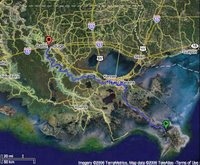Vicksburg, Mississippi… I Like This Place!
 400 miles into my walk
400 miles into my walk
It's been awhile since I've updated my trip. This morning I woke up and realized that I'd already walked nearly 80 miles through the state of Mississippi and not once have I said a thing about it. Well it's not because there's nothing to note… far from it. Mississippi has put spring in my step, though it is Autumn. The fresh fragrance of pines on the cool, crisp air is such a relief from the humid, warmer days I spent in Louisiana. I crossed the river at Vidalia and walked into the city of Natchez, Mississippi right at sunset. The weather was already turning cooler and the sky was talking Autumn with high, light wispy clouds.
I crossed the river at Vidalia and walked into the city of Natchez, Mississippi right at sunset. The weather was already turning cooler and the sky was talking Autumn with high, light wispy clouds.
I headed toward the southern terminus of the Natchez Parkway off of Liberty Road. Technically, this is the starting point of the historical "beginning" of the Old Trace at milepost zero. The 444-mile Natchez Trace Parkway commemorates an ancient trail that connected southern portions of the Mississippi River, through Alabama, to salt licks in today's central Tennessee. I walked along the Parkway for about 42 miles and saw some truly beautiful places: The Emerald Mound (one of the largest ceremonial mounds in the United States built and occupied between 1250 and 1600 AD by the ancestors of the Natchez people) and Mount Locust (standing on a land grant of 600 acres, dates from the English occupation of the Natchez District during the years 1763-1779 when it was part of British West Florida).
I walked along the Parkway for about 42 miles and saw some truly beautiful places: The Emerald Mound (one of the largest ceremonial mounds in the United States built and occupied between 1250 and 1600 AD by the ancestors of the Natchez people) and Mount Locust (standing on a land grant of 600 acres, dates from the English occupation of the Natchez District during the years 1763-1779 when it was part of British West Florida).
I veered off of the Natchez Parkway onto State Road 61 just south of Port Gibson to head due north towards Vicksburg. I knew that I would be back to walk the entire length of the Parkway, once I made it to Minnesota.
Now, Vicksburg is a really hip little city. It's has a pleasant mix of the old with the new. The Vicksburg National Military Park is probably the city's biggest draw. This park commemorates the campaign, siege and defense of Vicksburg during the Civil War. It is one of the most heavily monumented parks in the world with 1330 monuments, markers, tablets and plaques. The beauty and artistry of its monuments prompted one Civil War veteran to call this park, "the art park of the world.
As I walked along the many monuments within the park, I realized that most of the history I've been walking with along my Mississippi River trek had to do with war, natural disasters, and human suffering. It was time to look for lighter anecdotes. With winter coming on I needed side-trips that lifted my spirits and didn't remind me of the troubles, both past and present, of this world. That led me to Catfish Row Art Park. The Art Park at Catfish Row is a creative adventure into the history of the Mississippi River and the fabulous paddle wheel steamboats that once traveled it's mighty waters. It is a colorful park where sculptures are not monuments of past battles. It is a park nurtured by the community of Vicksburg. Art walls throughout the park are currently blank but will soon be transformed into beautiful historical works of art created by the people of Vicksburg. It is just the place I needed to see before continuing my journey north.
The Art Park at Catfish Row is a creative adventure into the history of the Mississippi River and the fabulous paddle wheel steamboats that once traveled it's mighty waters. It is a colorful park where sculptures are not monuments of past battles. It is a park nurtured by the community of Vicksburg. Art walls throughout the park are currently blank but will soon be transformed into beautiful historical works of art created by the people of Vicksburg. It is just the place I needed to see before continuing my journey north.
The air is now crisp and chilly. Winds are kicking up, blowing the last of the leaves my way. Winter will soon be here. And, as I hit the road, walking my way toward State Road 1, I reflect not on the wealth of history I've learned or the Thanksgiving meal I missed today, but on the many things I am thankful for each day. Happy Thanksgiving everyone.
Brian












































